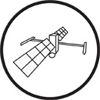 |
Canadian satellites |
Canadian Communications Satellites (since 1972) |
All Canadian communications satellites are commercial. The Canadian-based company Telesat is the main provider for Canadian government and corporate users. Its fleet includes Anik F2 (2004), which provides wireless broadband Internet connections in the most remote regions of Canada. |
 |
Canadian satellites |
SCISAT (2003) |
This small Canadian satellite monitors ozone in the stratosphere and helps scientists improve their understanding of ozone depletion, with a special emphasis on the changes occurring over Canada and in the Arctic. |
 |
Canadian satellites |
RADARSAT-2 (2007) |
Canada's next-generation commercial radar satellite enhances marine surveillance, ice monitoring, disaster management, environmental monitoring, resource management and mapping in Canada and around the world. |
 |
Canadian satellites |
CASSIOPE (2013) |
This hybrid small satellite gathers information to better understand the science of space weather, while demonstrating high-speed communications concepts through the use of space technologies. |
 |
Canadian satellites |
NEOSSat (2013) |
The world's first space telescope dedicated to detecting and tracking asteroids. It also sweeps the skies in search of satellites and space debris. |
 |
Canadian satellites |
Sapphire (2013) |
Canada's first operational military satellite monitors thousands of pieces of space debris, detects man-made objects in orbit, and provides data to the U.S.-led Space Surveillance Network dedicated to preventing collisions in space. |
 |
Canadian satellites |
M3MSat (2016) |
A microsatellite designed to test new technologies in space to advance Canada's ability to detect ships and manage marine traffic and improve the way we monitor the health and safety of satellites in orbit. |
 |
Canadian satellites |
RCM (2018) |
The RADARSAT Constellation Mission (RCM) will build on the success of previous RADARSAT missions. The three satellites will provide daily revisits of Canada's lands and oceans for maritime surveillance, disaster management and ecosystem monitoring. |
 |
International satellites with Canadian participation |
Cospas-Sarsat (since 1982) |
The Department of National Defence (DND) has long provided payloads to support Cospas-Sarsat in low-Earth orbit (LEO). DND is currently developing new payloads that aim to dramatically decrease search time and save more lives. |
 |
International satellites with Canadian participation |
Terra (NASA, 1999) |
Canada's MOPITT is one of five instruments on Terra. It contributes to the study of environmental pollution by continuously scanning the atmosphere to gather long-term measurements of global carbon monoxide levels. |
 |
International satellites with Canadian participation |
Odin (Sweden, 2001) |
Canada's Optical Spectrograph and InfraRed Imaging System (OSIRIS) aboard Odin measures concentrations of ozone, aerosols and nitrogen dioxide in the upper atmosphere. |
 |
International satellites with Canadian participation |
CloudSat (NASA, 2006) |
This satellite gathers data on the structure, frequency and volume of clouds to help improve our understanding of how they influence weather. Canada has been participating since 1998 and collaborates in related scientific work. |
 |
International satellites with Canadian participation |
THEMIS (NASA, 2007) |
This mission aims to identify the physical mechanism that leads to the explosive release of solar energy in substorms. Canadian scientists are involved in this mission by providing real-time monitoring of the visible consequences of substorms: the aurora borealis. |
 |
International satellites with Canadian participation |
SMOS (ESA, 2009) |
The purpose of this mission is to improve our understanding of the Earth's water cycle by mapping sea surface salinity and monitoring soil moisture on a global scale. SMOS also contributes to the study of the cryosphere. Canada has invested in this mission and supports scientific exploitation of its data. |
 |
International satellites with Canadian participation |
Swarm (ESA, 2013) |
By measuring the Earth's magnetic field from space, Swarm aims to separate the measured field according to its different sources: the Earth's core, mantle, crust, oceans, ionosphere and magnetosphere. This information will help scientists better understand how the core-generated magnetic field is evolving. Canada's space sector has contributed technology to the mission, and our scientists have access to its data. |
 |
International satellites with Canadian participation |
Sentinel (ESA, 2014) |
A family of six next-generation missions of the Copernicus program that will focus on different aspects of Earth observation. Canada is participating under the Canada/ESA Cooperation Agreement, and Canadian users benefit from simplified access to Sentinel data through a dedicated Data Hub. |

|
International satellites with Canadian participation |
SMAP (NASA, 2015) |
The purpose of this mission is to map soil moisture and its freeze/thaw state globally. SMAP's instruments measure conditions in the top 5 cm of soil. This data can be very useful, particularly for agriculture. Canada is collaborating in the scientific aspect of the mission. (Credit: NASA/JPL-Caltech/GSFC) |
 |
International satellites with Canadian participation |
EarthCARE (ESA/JAXA, 2019) |
EarthCARE will deliver unprecedented data to scientists studying clouds, aerosols and radiation at accuracy levels that will significantly improve our understanding of these highly variable elements. Canada is contributing technology to the mission and will participate actively in science activities leading up to and during the mission. |
 |
International satellites with Canadian participation |
SWOT (NASA, 2020) |
This mission will survey 90% of the Earth's lakes, rivers and oceans using altimetry technology to provide a comprehensive picture of the world's oceans and freshwater bodies. Canada is contributing technology and will be an equal partner in the mission's science working group. |
 |
International satellites – Accessible data and services |
Global navigation satellite systems (GNSS) |
Global navigation satellite systems (GNSS) provide positioning, navigation and timing information. Canadians benefit particularly from the use of the United States' Global Positioning System (GPS). Other systems include the European Union's Galileo, Russia's GLONASS and China's COMPASS (Beidou). |
 |
International satellites – Accessible data and services |
Earth observation satellite systems |
Earth observation satellite systems are critical for environmental monitoring, meteorology, disaster response, agriculture and many other applications that can improve life on Earth. A number of programs and technologies exist worldwide. Canada benefits from increasingly open access to data from many of these systems. |
 |
International satellites – Accessible data and services |
Telecommunication satellite systems |
Telecommunication satellite systems from around the world enhance access to the advanced services needed to compete in the global knowledge economy. |





















